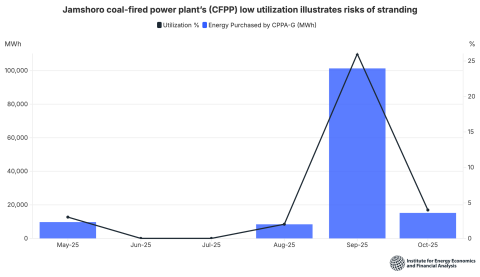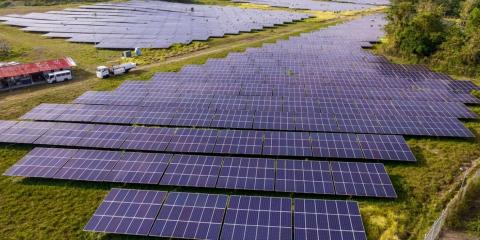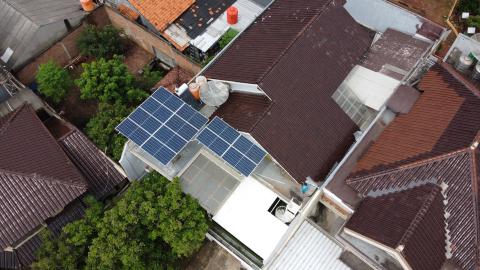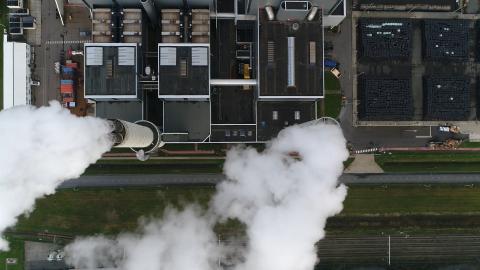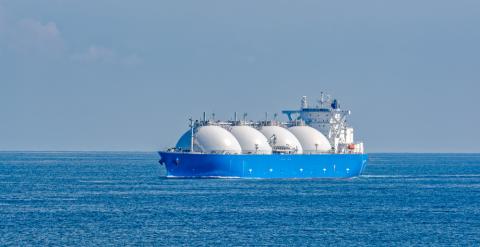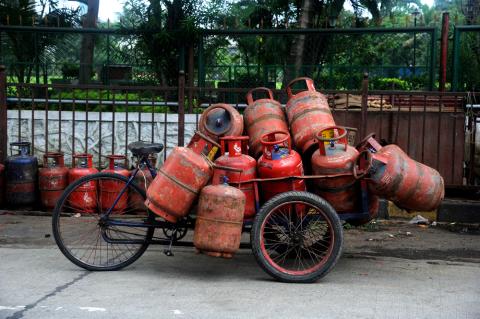Surging electric truck sales stall China's LNG trucking boom
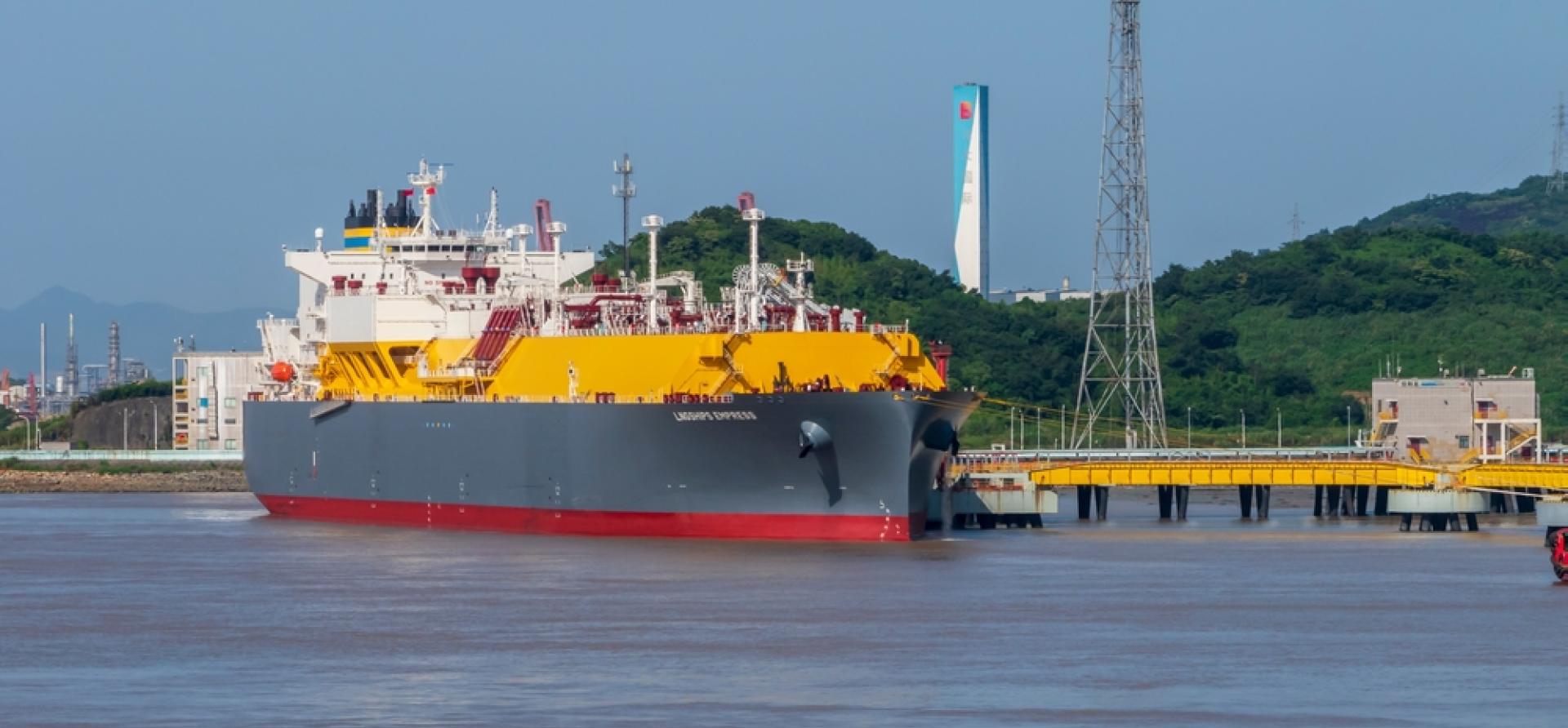
Key Findings
China’s battery-electric truck sales are surging, capturing almost 22% of the market in the first half of 2025, up from 8.6% in the same period of 2024. Heavy-duty vehicle (HDV) fleet operators may be adopting electric alternatives because of a 10% to 26% lower cost of ownership compared to diesel models.
Liquefied natural gas (LNG) heavy truck sales are declining in 2025 as LNG’s cost advantage over diesel falls and competitive battery-electric alternatives gain ground. The diesel-LNG price differential has dropped by two-thirds since 2024, when LNG truck sales set monthly record highs.
Establishing a standardized, swappable heavy-duty battery and battery swap stations across China’s key freight corridors could accelerate electric heavy-duty truck sales. Leading manufacturers expect battery-electric vehicles to capture 50% to 80% of heavy-duty truck sales by 2028.
China’s LNG trucking boom may remain a domestic trend with little impact on global LNG flows. Other Asian countries lack the conditions to emulate this trend, and Chinese HDV manufacturers may accelerate the electrification of heavy trucking abroad via exportation as they seek new markets to improve profitability.
Sales of electric heavy trucks are surging in China, according to new data from Commercial Vehicle World (CV World), a Beijing-based data provider that tracks the country’s trucking sector. This trend dims prospects for long-term liquefied natural gas (LNG) demand in the transportation sector, which global LNG players often cite as a key growth driver.
In the first half of 2025, battery-electric models accounted for 22% of all heavy-duty vehicle (HDV) sales, up from 8.6% in the same period of 2024. In June 2025, new energy vehicle (NEV) sales reached a monthly record of 18,007 units. While NEVs include fuel-cell and hybrid vehicles, battery-electric models dominate the heavy trucking segment.
Meanwhile, LNG-fueled HDV sales are losing momentum. After capturing almost 30% of the market in 2024, the share fell to 26% in the first half of 2025. For two consecutive months, NEVs outsold LNG vehicles in the heavy truck segment. More broadly, NEVs surpassed the sales of all other vehicle types, and commentators estimate that electric trucks are displacing over one million barrels per day in implied diesel demand.
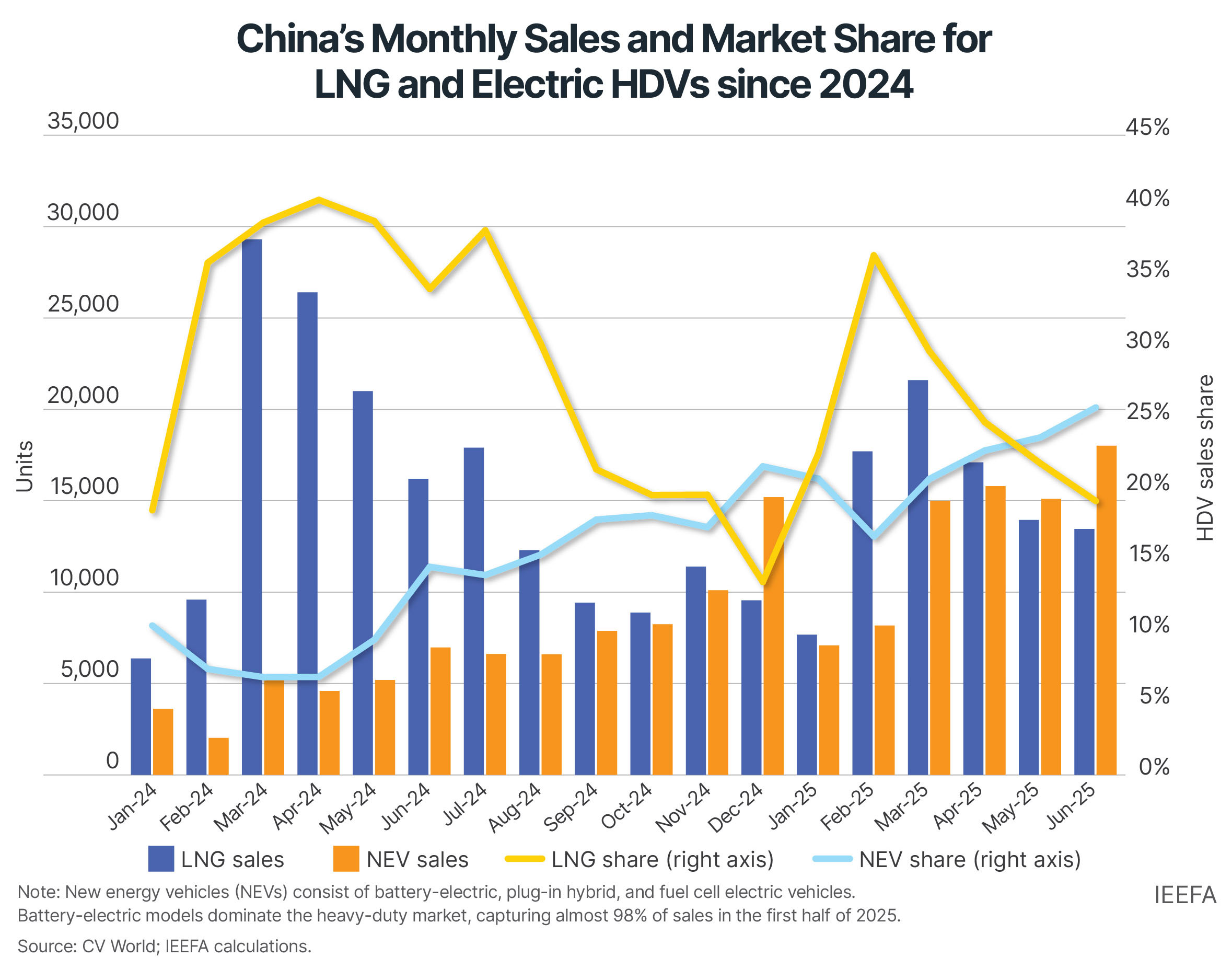
This is consistent with a recently published report by the Institute for Energy Economics and Financial Analysis (IEEFA), which found that LNG price volatility and increasingly competitive electric alternatives could limit LNG’s role in fueling HDVs.
The relative cost of LNG to diesel has been rising
LNG truck sales are highly sensitive to LNG and diesel prices. Higher LNG prices increase the payback period for LNG truck investments, which cost 18% more upfront than diesel models in China but can offer savings through lower fuel costs.
While LNG prices were stable in the first half of 2025, diesel prices showed more downside, narrowing the spread between them. On average, the LNG-diesel price differential was 16% lower than the previous year.
LNG heavy truck sales achieved monthly records when the diesel-LNG spread reached its widest point in 2024. In May 2025, however, the differential was nearly two-thirds lower than last year’s peak. As NEV sales have increased, LNG truck sales have declined with falling diesel prices. This occurred despite the government qualifying LNG-fueled trucks for purchase subsidies in March 2025.
Electric alternatives are emerging as cost-effective solutions for heavy-duty applications
This slowdown in LNG adoption suggests that fleet operators may be actively choosing electric alternatives because of the lower cost of ownership.
In May 2025, IEEFA’s report found that while China’s electric heavy trucks can cost 62% to 255% more than diesel models, their total cost of ownership is 10% to 26% less. This is mainly due to the lower fuel costs and higher fuel economy of battery-electric drives compared to internal combustion engines. China’s higher purchase subsidies for electric models could also encourage fleet operators to opt for electric purchases.
Recent advancements in battery swapping could accelerate this trend. Battery swapping reduces refueling timeframes to levels comparable to diesel vehicles, increasing truck utilization and profit margins for fleet operators.
Battery swapping transfers the battery cost component from the fleet owner to the station operator. Since batteries account for over half the current cost of electric trucks, this shift can reduce the payback periods for adopting electric vehicles.
Moreover, CATL, the world’s largest power battery manufacturer, estimates that swap-capable heavy trucks have an operational cost advantage of USD8,320 per 100,000 kilometers – about three times that of LNG models.
Battery swapping currently comprises about a third of battery-electric heavy-duty truck sales in China, and industry players are actively working to remove or lower adoption hurdles.
In May 2025, Qiji Energy, a subsidiary of CATL, introduced “75#”, a new standardized, swappable battery pack model for heavy-duty trucks. Its system is compatible with 30 heavy truck models from a dozen manufacturers.
Meanwhile, CATL aims to deploy 300 battery swap stations for heavy trucks along China’s freight corridors by the end of 2025 and expand the service into 16 city clusters nationwide by 2030. CATL’s chief executive officer projects that the heavy truck market will achieve a 50% electrification rate by 2028.
Sany Group, China’s top-selling electric heavy truck manufacturer, is more bullish, anticipating a 70% to 80% penetration rate over the same period.
Even the leading LNG truck manufacturers will benefit if these projections play out. China’s top five LNG truck manufacturers are also among the top seven electric model producers, accounting for over half of the country’s electric heavy truck sales this year. Increased battery adoption by heavy truck fleet operators is unlikely to face resistance from LNG-fueled manufacturers who are simply shifting sales within their product offerings.
LNG trucking’s transitional role spells trouble for LNG proponents
The recent acceleration in electric heavy truck sales, advancements in battery standardization, and expansion of the heavy-duty battery swapping network in China could limit the long-term role for LNG in the country’s transportation sector.
More importantly, the LNG trucking boom may emerge as largely a mainland China phenomenon with little impact on global LNG flows.
Within China, domestic LNG production is sufficient to meet the transport sector’s fuel demand. This liquefaction capability from low-cost gas sources — such as domestic production, pipeline imports, and byproduct coke oven gas — is growing. LNG imports are typically too expensive to compete with this supply.
Elsewhere across Asia, most countries lack the infrastructure, manufacturing capability, and lower-cost gas feedstocks to emulate China’s LNG trucking boom. Moreover, if China’s manufacturers expand battery-electric exports to improve profitability, that will further complicate LNG trucking’s path to relevancy across the region.
As heavy-duty truck adoption seems unlikely to drive LNG flows amid an increasingly fragile demand outlook, LNG proponents will need to reconsider their justifications for further expansion.





